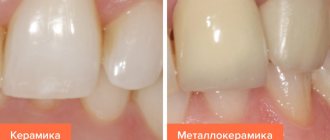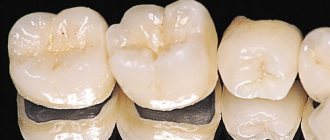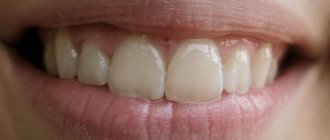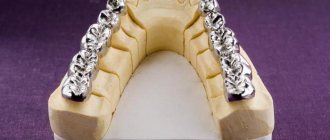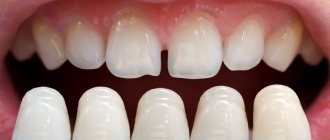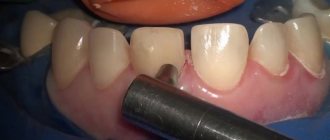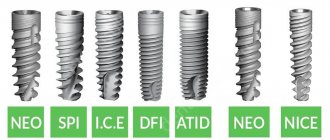What kind of prosthesis is this and what features does it have?
An acetal denture is a partial removable [1] orthopedic structure made of synthetic resin (polyacetal). It is light and durable, allowing you to make comfortable dentures for installation on the upper or lower jaw with partial absence of teeth. Acetal is most often used to make crowns, hooks or clasps (fixing components), frames or arches, and less commonly - core inlays, gum formers for installation on implants. Removable acetal ones are attached to the supporting teeth using clasps.
PROSTHETIC PROSTHETICS WITH 4 STRAUMANN IMPLANTS “teeth in 1 day” - RUB 220,000. until January 15, 2022!
Complex implantation using ProArch technology (Switzerland) with immediate loading on the day of surgery!
Call now or request a call
Acetal removable dentures are distinguished from others by the shade of the clasps, frame (arch), and palatal bridge on the upper jaw. If, for example, clasp ones are gray metallic, and acrylic and nylon ones are translucent pink, then acetal ones are white or milky matte, not transparent.
What material is used
Acetal (more precisely, polyacetal, polyformaldehyde, polyoxymethylene) is an organic thermoplastic compound discovered about 100 years ago. The material is initially crystalline and has a white, or rather milky color, and is opaque. Some manufacturers color the material according to the Vita scale in 15-17 shades for artificial teeth and pink shades for gums. The material is supplied marked: “Acetal plastic” or “monomer-free acetate plastic”. Quality brands – Evihard, Nuxen, Pressing Dental Srl
Acetal is hydrophobic, i.e. does not absorb oral fluid, saliva, or water at all. It is resistant to alkalis, but can be destroyed in an acidic environment, so you should be careful when consuming acidic foods and drinks.
In terms of strength, polyacetal can be compared with a cobalt-chromium alloy - they have approximately equal characteristics in terms of distribution of chewing load, resistance to abrasion and deformation during long-term use. The material melts at a temperature of 180 degrees Celsius, i.e. You can safely consume hot food and drinks. The absence of toxic acrylic monomer in the composition greatly reduces the risk of an allergic reaction.
Indications and contraindications
Indications for the installation of acetal prostheses are the following cases:
- the need to restore 1-2 or more teeth: for good fixation and load distribution, at least 6-7 teeth must be preserved in the row,
- the remaining teeth exhibit mobility of the 1st degree,
- increased abrasion of enamel,
- included and end defects: in the first case, teeth are preserved along the edges of the “gap” (where there is no tooth), in the second case there are no teeth at the edge of the row,
- inflammation of the gums: gingivitis, periodontitis,
- inconvenience in wearing other orthopedic structures: for example, if acrylic ones cause discomfort due to their massiveness, and clasp ones provoke galvanosis (the appearance of an electrical impulse between dissimilar metals),
- allergies to other synthetic materials and metals,
- the need for temporary prosthetics before implantation, if it is not yet possible to install implants.
Contraindications are such clinical cases as:
- complete or almost complete edentia (absence of teeth),
- pronounced mobility of the remaining supporting teeth,
- severe atrophy of the alveolar ridge (loss of bone and gums),
- allergic reaction to the material or increased sensitivity of the gums,
- small sizes of supporting crowns: hook-clasps will not be able to attach well to them, they will fly off or overload this area.
Patient reviews
Although acetate dental products have only recently begun to be manufactured, there are already many positive reviews about them. Patients note the high quality of the product and the ease of wearing the design.
Four years ago I was fitted with a prosthesis. The device turned out to be inconvenient: it often chafed and could barely stay in my mouth. While eating I felt terrible discomfort. I decided to contact another specialist, who examined me and recommended using an acetal construction. After installing the new prosthesis, it took about a month to get used to the new product. But then the product was almost not felt. The device is easy to clean, holds securely, does not interfere with eating and does not rub. In addition, it looks natural.
Konstantin
Two years ago, the dentist said that I needed to get dentures. Implants were excluded due to the location and number of missing teeth. The prosthetist prescribed products made from different materials, but I was allergic to some of them, and others turned out to be too harsh. Then the specialist prescribed a device made on the basis of acetal. It took me a long time to get used to the design, but after two months the discomfort went away. There was no irritation. The prosthesis itself is comfortable and easy to care for. I only remove it for cleaning in a solution.
Olga
I have been wearing acetal dentures for six months now.
It is difficult to compare with products made from other materials, since this is the first design that the doctor prescribed. The device is comfortable to wear and does not cause discomfort or irritation. People around me don’t even notice the difference between my real and artificial teeth. The dentures are light, high quality and beautiful. I'm very pleased with them. Irina
Types of orthopedic structures
The classification identifies several options for acetal dentures. Depending on the location of installation, it can be on the lower or upper jaw. In length – an immediate prosthesis (“butterfly”) for 1-2 teeth and an extended orthopedic structure that restores multiple and/or scattered defects in a row. As a rule, the last option is most often used, because The material is too hard for a butterfly.
As for popular varieties, they can be as follows:
- prosthesis with acetal clasps,
- clasp acetal dentures for the upper and lower jaws.
Clasp prosthesis made of acetal (without metal)
Such a device can be called a complete analogue of the clasp one. Only in acetal, the arch or frame is made of white acetal - there is no metal at all in this orthopedic design. Pink gum is built up on top of the arch; it can also be made of acetal or more transparent and elastic acrylic. Hooks or clasps are also made of acetal. Artificial teeth can be made from the same material, or they can be made from more pliable plastics. For attachment to the upper jaw there is an acetal palatal bridge. According to patient reviews, acetal dentures are lighter than classic clasp dentures with hooks, and are fixed in the oral cavity just as reliably.
Clasp metal with acetal clasps
In a traditional clasp denture, there is a metal arch inside and metal clasps on top - they grip the supporting teeth like small processes or “claws”. But when you smile, gray clasps can be noticeable. Therefore, it is allowed to make hooks from acetal, but leave the arc metal.
Read more about all possible prosthetic options for partial absence of teeth on one or two jaws.
Design features
The doctor minimally grinds the teeth for fastening elements. This is the main difference between acetal and plastic dentures.
Elastic acetal clasps practically do not injure the mucous membrane. If reliable and stable fixation is necessary, a combination with metal is used. The acetal insert acts as an attachment.
Manufacturing and installation
The dentist conducts a clinical examination and sanitation of the oral cavity. The design of the prosthesis is selected.
Upon completion of the preparatory stage, an impression is taken. It is always performed on both jaws to ensure correct bite correction. The impression is made from silicone compounds.
Model manufacturing algorithm:
- Creation of a plaster model in the laboratory.
- Applying wax rollers to the cast.
- The finished model with rollers is transferred to the dentist to determine the individual specifics of the bite and fitting.
- Model adjustment in laboratory conditions.
- Manufacturing of base and artificial units.
- Repeated fitting.
- Creation of a prosthesis from polyacetal.
- Installation of the product.
Standard technologies for installing prostheses are used. The structures are fixed to healthy teeth or artificial supporting bridges are used.
Features of care
The design features allow you to wear the prosthesis without removing it for up to three days. Twice daily cleaning of the oral cavity with non-abrasive pastes is necessary.
Special tablets will allow you to remove bacterial plaque from the surface of the product. The removable system is placed in a solution with water for the time specified in the instructions. Then the product is cleaned with a toothbrush. It is advisable to carry out ultrasonic cleaning in a dental setting.
Patients' opinions
Prosthetic structures are popular among patients and dentists. Despite the complexity of manufacturing, the prostheses demonstrate high performance. Patients quickly get used to wearing the products. Gentle fixation mechanisms do not injure tissue.
If one unit is lost, such a prosthetic design will become a temporary solution to the problem.
Installation restrictions:
- Loose units.
- Edentia.
- If you have braces.
- Malocclusion.
Avoidance of rough foods and thorough chewing will help speed up the addiction to the product. It is recommended not to remove the system for the first few nights.
Advantages and disadvantages
If we consider the pros and cons of acetal dentures, then they provide more benefits for patients - in comparison with conventional acrylic or even reliable clasp structures. The advantages of acetal products are as follows:
- good fixation on the teeth and uniform distribution of the chewing load (in comparison with acrylic ones): this is facilitated by fairly rigid acetal clasps and frame,
- ease of design and its installation in the oral cavity,
- good aesthetics: white clasps are not as noticeable on the teeth as gray metal ones,
- quick adaptation: the acetal removable denture on the upper jaw has only a thin bridge, and on the lower jaw there is a small imitation of gum, so it does not overlap the taste buds so much, distorts diction less, and does not provoke nausea,
- relatively simple care: there is no need to remove the denture every time after eating,
- acetal clasps put less pressure on crowns, so the enamel does not wear off as much as with metal hooks,
- flexibility and lower risk of breakage: the acetal frame can be bent 90 degrees, and it will not break or bend - it will return to its original position. Patients note that if they fall from a height (with careless handling), the prosthesis may not crack/break,
- you can get dentures for periodontal diseases, for loose teeth (but not in severe cases),
- low risk of allergies,
- low cost.
Disadvantages include factors such as:
- rigidity of the orthopedic structure: can provoke increased atrophy of bone tissue, loosening of teeth due to periodontitis (if the patient places or removes it incorrectly),
- as atrophy progresses, chafing on the gums, pain, stomatitis,
- when worn for a long time, you have to glue the prosthetic base onto a fixing cream (“Koregu” or “Protefix”),
- chewing with removable dentures is not very comfortable: only 6 out of 10 people say that they are relatively comfortable using removable devices,
- opacity of the material: therefore, the aesthetics here are lower than, for example, nylon,
- over time, the material absorbs dyes from food, becomes colored by tobacco smoke, darkens from plaque,
- there is a risk of breakage of individual clasps.
How much does acetal construction cost?
The cost of the product will directly depend on the characteristics of the clinical picture and the location of its fixation. The price is affected by the number of missing teeth and the material for the clasps. Such a prosthesis will cost around 25-30 thousand rubles. This amount includes all related work to create and fix the structure. But the removal of damaged and rotten teeth and preliminary treatment of pathological processes will have to be paid separately.
Acetal orthopedic devices are widely popular today, although they have a number of disadvantages. Experts recommend them as a temporary measure. The best solution for restoring teeth is implantation - this is the only method that allows you to stop atrophic processes in bone tissue and restore a beautiful smile for many years.
1Zhulev EH Partial removable dentures: theory, clinic and laboratory technology, 2000.
How is production and installation carried out?
First, the patient undergoes diagnostics (examination, x-rays), sanitation of the oral cavity (removal of diseased and damaged teeth). After that, impressions are taken from the dentition, and an individual impression tray is made. Next, impressions are made again, a working model is made, and the future orthopedic product is cast and pressed on it.
The manufacturing technology of an acetal prosthesis is quite complex, and such a design is created only in a dental laboratory with modern equipment. Since acetal granules begin to melt at a temperature of 180 degrees Celsius, a thermal injection press will be required to make the prosthesis.
Then the finished structure or arch with clasps is cooled and tried on a model or directly to the patient. Next, gums are added to the frame, crowns are placed, the product is polished and sent for final fitting. If there are no shortcomings, it is installed for the patient.
Service life and care
The service life of a removable acetal prosthesis is 3-5 years. With good care it can be extended a little. To do this, you need to regularly remove the structure from your mouth for cleaning and disinfection (once every 1-2 weeks), because without proper cleaning, the surface will quickly darken. In addition, you need to brush your teeth twice a day - your own and artificial ones, using a special brush and toothpaste. To prevent breakage and displacement during the act of chewing, you should avoid hard and stretchy foods. Do not chew candy or nut shells, avoid toffees and toffees, and do not open jars with your teeth. You should also regularly visit an orthopedic dentist for examination and correction of the prosthesis, minor repairs and cleaning if necessary.
Alternatives to acetal prosthesis
An alternative among removable ones can be any partial removable one - acrylic, nylon, Acry-free. But the clasp and Quattro Ti (“Quadrotti”) are considered the closest, since they, along with acetal, have compact sizes and a thin palatal bridge for fixation on the upper jaw.
But these are all removable options that do not stop, and sometimes even worsen, the atrophy of the jaw bone tissue - experts recommend them only for temporary wearing. Therefore, the best way to permanently restore lost teeth is implantation. Here the orthopedic structures are attached most reliably, there is no need to remove them, and they are very easy to care for. Plus, bone atrophy stops, because the implant, as an analogue of the root, correctly transfers the load to the bone tissue.
“A former classmate once recommended a good dentist, who installed implants for my crowns. About prosthetics they said that only in six months. But without teeth you can’t walk, you can’t smile, you can’t talk. So the doctor chose a good acetal prosthesis for me. For a while. As long as I wear it normally, I haven’t noticed any problems. But, of course, I already want to get the crowns installed as soon as possible. There is no need to remove them to clean them.”
Sergey_76, review from irecommend.ru
Oral care after dentures
Acetal dentures are quite easy to use - they do not need to be removed at night, you just need to carry out standard hygiene measures to maintain oral health. You can brush your teeth with such prosthetic structures in the usual way, but at least twice a day. Your doctor will tell you which toothpaste and brush to choose in order to preserve the beauty of your smile for a long time during the consultation after installing the product.
Dentures made from acetal should be immersed in a special disinfectant solution once a day. It is enough for the prosthesis to remain in this liquid for half an hour. In this way, the hygienic and aesthetic properties of the dental prosthetic structure can be preserved.
Modern science and medical technology are advancing at an impressive rate, and dental orthopedics takes advantage of many of these advances. If the question of dental prosthetics arises, there is no need to be afraid for the aesthetics and hygiene of the products that the doctor will offer. Acetal prosthetic products are one of the options for solving the problem of how to restore a beautiful smile, and with it, self-confidence.

